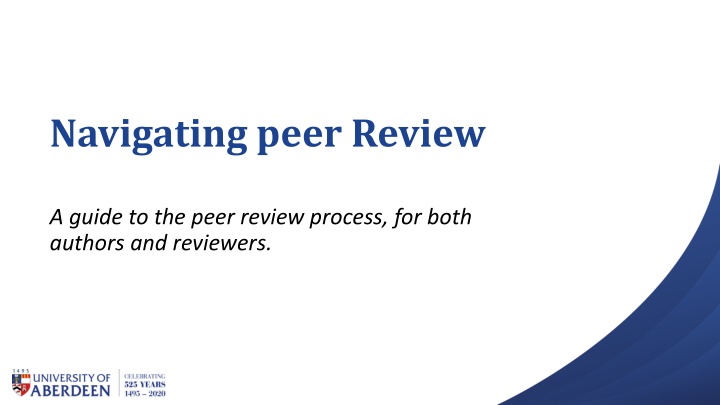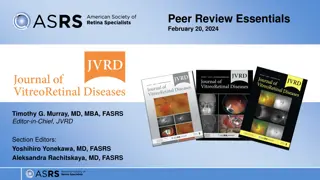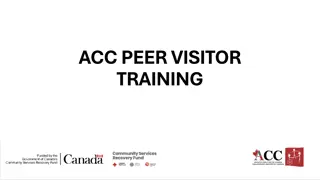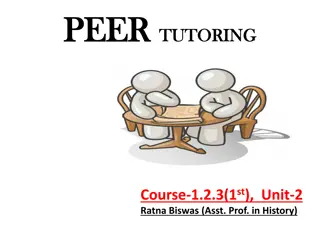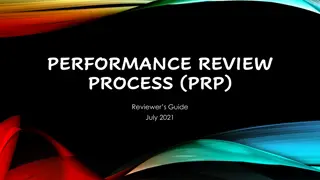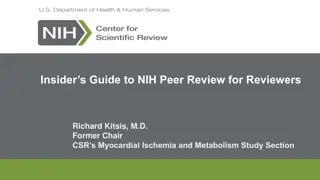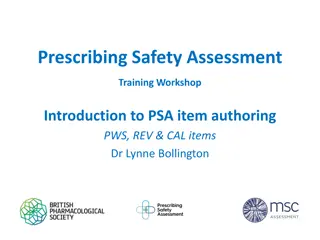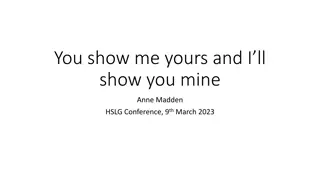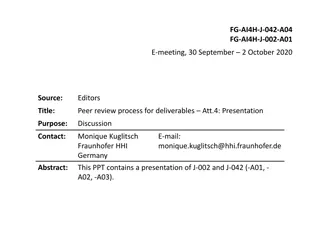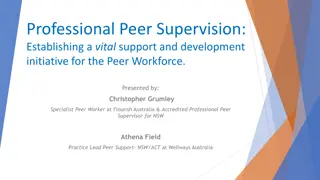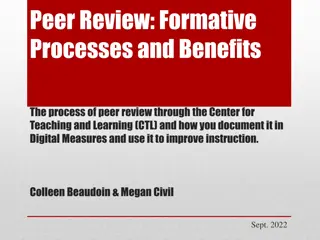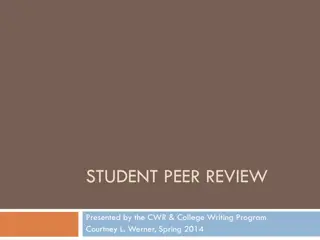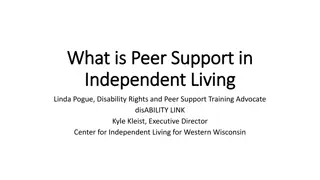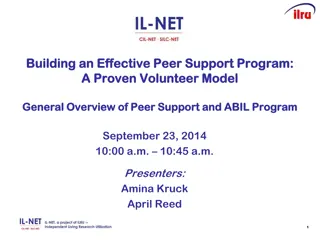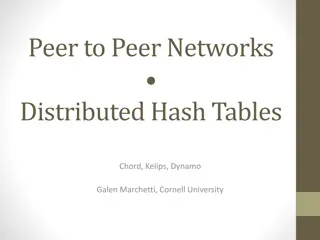Navigating Peer Review: A Comprehensive Guide for Authors and Reviewers
In academic publishing, peer review plays a crucial role in maintaining publication quality. This guide offers a detailed overview of the peer review process for both authors and reviewers, covering topics such as receiving review invitations, manuscript submission, writing effective reviews, and more. Explore the mechanisms of peer review and understand its importance in enhancing the quality and credibility of scholarly work.
Download Presentation

Please find below an Image/Link to download the presentation.
The content on the website is provided AS IS for your information and personal use only. It may not be sold, licensed, or shared on other websites without obtaining consent from the author.If you encounter any issues during the download, it is possible that the publisher has removed the file from their server.
You are allowed to download the files provided on this website for personal or commercial use, subject to the condition that they are used lawfully. All files are the property of their respective owners.
The content on the website is provided AS IS for your information and personal use only. It may not be sold, licensed, or shared on other websites without obtaining consent from the author.
E N D
Presentation Transcript
Navigating peer Review A guide to the peer review process, for both authors and reviewers.
Introduction In the field of academic publishing, control over publication quality is essential. The system of peer review is a way to ensure this, as it involves the expert evaluation of every publication. In your career, you might be led to both submitting articles for publication, and reviewing articles written by academic peers. This guide will cover the tasks of both authors and reviewers, after a presentation of the process of peer review.
Contents I. The peer review process III. Reviewers a. Why peer review? a. Getting started b. The mechanisms of peer review II. Authors b. Receiving a review invitation c. Reviewing the manuscript d. Writing the review a. Writing your manuscript e. Recommendation to the editor Summary and Resources b. Submitting your manuscript c. Revising your manuscript
I. The peer review process A quick overview and explanation of the peer review process.
a. Why peer review? A survey from the Publishing Research Consortium (2015) asks academic authors about peer review: 82% agreed that without peer review there is no control in scientific communication. Peer review is effective for: Improving the quality of the published paper. Determining the originality of the manuscript. Determining the importance of the findings. Detecting fraud. Detecting plagiarism. 74% agreed peer review improves the quality of the published paper. You can find the study here.
Author chooses a journal Paper is rejected Editor rejects it Author is asked to make revisions Editor assesses the reviews and makes a decision Author submits to journal Editor sends the manuscript to reviewers The paper is published PEER REVIEW Paper is accepted without further revisions Editor screens the manuscript b. The mechanisms of peer review
Author chooses a journal Paper is rejected Editor rejects it Author is asked to make revisions Editor assesses the reviews and makes a decision Author submits to journal Editor sends the manuscript to reviewers The paper is published PEER REVIEW Paper is accepted without further revisions Editor screens the manuscript The author submits their manuscript for a first screening from the editor. The author needs to choose a journal which fits their field of study, and read that journal s guidelines. Usually, the submission is done electronically.
Author chooses a journal Paper is rejected Editor rejects it Author is asked to make revisions Editor assesses the reviews and makes a decision Author submits to journal Editor sends the manuscript to reviewers The paper is published PEER REVIEW Paper is accepted without further revisions Editor screens the manuscript The manuscript could be rejected by the editor at this stage. The paper could be rejected if: The topic is nor suitable for the journal. The author has failed to follow the journal s guidelines. The paper is too similar to one that has already been published. The author revises their manuscript and attempts to submit it to a different journal.
Author chooses a journal Paper is rejected Editor rejects it Author is asked to make revisions Editor assesses the reviews and makes a decision Author submits to journal Editor sends the manuscript to reviewers The paper is published PEER REVIEW Paper is accepted without further revisions Editor screens the manuscript After accepting the manuscript, the editor reaches out to reviewers. Journals usually aim for 2 reviewers per paper. The editor has a database of reviewers, and finds the ones with expertise in the topic and/or method covered in the paper. The reviewers can choose to accept or decline the review offer. They are given a few weeks to return the review.
Author chooses a journal Paper is rejected Editor rejects it Author is asked to make revisions Editor assesses the reviews and makes a decision Author submits to journal Editor sends the manuscript to reviewers The paper is published PEER REVIEW Paper is accepted without further revisions Editor screens the manuscript The manuscript is sent to the reviewers. The reviewing process consists of checking: The relevance and novelty of this article in its field. Its overall structure and readability. Its appropriate use of sources and methodologies.
Author chooses a journal Paper is rejected Editor rejects it Author is asked to make revisions Editor assesses the reviews and makes a decision Author submits to journal Editor sends the manuscript to reviewers The paper is published PEER REVIEW Paper is accepted without further revisions Editor screens the manuscript There are different kinds of peer review: The peer reviewers know who the authors are, but the authors do not know who the peer reviewers are. Single blind Neither party knows who the others are: the authors do not know who the peer reviewers are and the authors names are not disclosed to the peer reviewers Double blind Both parties know who the others are: the peer reviewers are given the authors names and the authors are told the peer reviewers names when they receive the review comments. Open
Author chooses a journal Paper is rejected Editor rejects it Author is asked to make revisions Editor assesses the reviews and makes a decision Author submits to journal Editor sends the manuscript to reviewers The paper is published PEER REVIEW Paper is accepted without further revisions Editor screens the manuscript The editor makes a decision based on the reviews, and their own evaluation of the paper. The editor can choose to: REJECT the manuscript REVISE with MAJOR revisions needed. REVISE with MINOR revisions needed. ACCEPT with no revisions.
Author chooses a journal Paper is rejected Editor rejects it Author is asked to make revisions Editor assesses the reviews and makes a decision Author submits to journal Editor sends the manuscript to reviewers The paper is published PEER REVIEW Paper is accepted without further revisions Editor screens the manuscript The paper does not pass peer review and is rejected by the editor. The author receives comments from the reviewers, and should use them to revise the manuscript before submitting it to another journal.
Author chooses a journal Paper is rejected Editor rejects it Author is asked to make revisions Editor assesses the reviews and makes a decision Author submits to journal Editor sends the manuscript to reviewers The paper is published PEER REVIEW Paper is accepted without further revisions Editor screens the manuscript The author is asked to revise the manuscript. The author bases the revisions on the comments of the reviewers. If MAJOR revisions are needed, the manuscript needs to be checked by the reviewers once again before publication. If MINOR revisions are needed, the manuscript is only checked by the editor, and not the reviewers.
Author chooses a journal Paper is rejected Editor rejects it Author is asked to make revisions Editor assesses the reviews and makes a decision Author submits to journal Editor sends the manuscript to reviewers The paper is published PEER REVIEW Paper is accepted without further revisions Editor screens the manuscript The paper does not need any more revisions, and is ready to be published! Sometimes the manuscript does not need any revision at all, but this is rare. The paper is edited and proofread by the journal, then is published.
Author chooses a journal Paper is rejected Editor rejects it Author is asked to make revisions Editor assesses the reviews and makes a decision Author submits to journal Editor sends the manuscript to reviewers The paper is published PEER REVIEW Paper is accepted without further revisions Editor screens the manuscript How do you fit in this process, both as an author and as a reviewer?
II. Authors How to successfully submit a manuscript.
a. Writing your manuscript The reviewers will be looking at the structure and clarity of your paper, as well as its use of sources and methodologies. Here are some ideas of what will be evaluated during the peer review process, if you are writing for a scientific journal. Results Discussion Is your interpretation backed up by results? Have you pointed out the limitations? Has the question been answered? Title and abstract Does the title reflect the research question? Does the abstract accurately describe the research methods and findings? Methods Are they described clearly enough for others to repeat them? Are they appropriate for the research question? Are they ethical? Introduction Is the research question clear? Why is the research important? Are the most relevant sources cited? Are they well- described? Are they clearly presented? (i.e. are figures and tables readable?) Are all patterns and correlations accounted for? You can find more information on this in this webinar from Zo Mullan, founding editor of The Lancet Global Health, published by Elsevier.
a. Writing your manuscript Here are some ideas of what will be evaluated during the peer review process, if you are writing for a journal in the field of arts and humanities. Title and abstract Does the title reflect the research question? Does the abstract accurately summarise the content of the article? Introduction Is the research question clear? Why is the research important? Are the most relevant sources cited? Have you pointed out the limitations of your approach? Have any theoretical perspectives been explained? Argument Conclusion Does it follow from your argument? Has the question been answered? Is the significance of your contribution clear? Can you suggest further work in that area? Style Does it address the question you have set? Is it well structured? Have you covered the relevant source material and backed up your claims with evidence? Is your writing clear and engaging? Is your use of technical language appropriate for your audience? Have you followed the journal s style guidelines?
b. Submitting your manuscript Only submit your manuscript to one journal at the time. Only approach other editors if you have been rejected by your first choice of journal. Before submitting your manuscript, make sure that its aims align with the focus of the journal. Editors will not be interested in publishing your work if that is not the case. Information regarding the focus and aims of a particular journal can be found on its website. the article s structure the journal s preferred reference style instructions for graphical figures and illustration instructions for the acknowledgements and biography and more! Remember to consult and follow the journal s author guidelines. They are usually found on their website, and cover essential information regarding
b. Submitting your manuscript Here are examples of journals guidelines for authors, from the journals Nature and Past & Present. You can find this page here. The screenshot was taken in Jan 2020. You can find this page here. The screenshot was taken in Jan 2020.
c. Revising your manuscript If your manuscript needs revisions, or if it is rejected, it is important to take into account the reviewers comments on your work. These could include comments about: the methodology, your use of sources, the construction of your argument, the clarity of your tables and illustrations, etc. Make sure you revise your manuscript according to the reviews before submitting it again. However, if you disagree with peer reviewers, and feel that it would be appropriate to defend your work, you can get back to the editor to let them know about the situation.
III. Reviewers How to efficiently review a manuscript.
a. Getting started Get involved in peer review to: Contribute to the academic community. Enhance your reputation or career, and distinguish yourself as an expert in your field. Stay up-to-date with emerging research in your field. Ways to get involved in peer review Ask your supervisor to co-review with them on a review Contact the editor of the relevant journal(s) Network with editors at conferences Get involved in post-publication commenting online
b. Receiving a review invitation Are you able to respect the deadline? The average review takes a few hours to complete. These are important elements to consider before accepting a review invitation. Do you have the appropriate knowledge and expertise? The editor is looking for an expert s opinion. Do you understand the focus of the journal? The reviewers guidelines are found on the journal s site, or invitation email. Tell the editor about any doubts you may have regarding these questions. Are there any conflicts of interest? Do you work in the same institution as the author, or have collaborated before, etc. Accept or decline the invitation as promptly as you can, so as to not slow down the publication process! When declining, you may suggest alternative reviewers, if possible. The correspondence about the manuscript should remain confidential before, during, and after the peer review process.
c. Reviewing the manuscript It is essential to read through the whole manuscript before writing any review. You may want to focus on the following aspects of the article: The content and structure Are the arguments clear? Do the title and abstract reflect the content of the article? Are the tables/figures/images relevant and clear? Does the evidence support the conclusions? The sources and methodology Has the author used relevant sources? Is the methodology appropriate for the research question? Is the methodology well- described? The topic Is it appropriate for the journal? Does it contribute and add to the knowledge of its academic field? Does it answer a relevant question? Do NOT correct typos or spelling mistakes! It is time-consuming, and is the task of the journal s copy editors. You could address spelling problems in one or two sentences in your review.
d. Writing the review Reviews can be structured in different ways. However, here are some important considerations: 1. Overview 2. Major comments 3. Minor comments How do you interpret the points made in the paper? How does it contribute to your academic field? Main strengths and weaknesses? These are problems that affect the understanding of the paper. Be precise! Refer to specific extracts and suggest ways to improve the paper. These can include: confusing sentences, unclear figures, incorrect references, etc. Similarly, being precise will facilitate the author s revisions. Remember that your goal is to help improve the paper, so it is important to keep a constructive tone. You can find more information on this in this webinar from Zo Mullan, founding editor of The Lancet Global Health, published by Elsevier.
e. Recommendation to the editor You can recommend one of four choices to the editor: REVISE with MINOR revisions needed. REVISE with MAJOR revisionsneeded. REJECT the manuscript ACCEPT with no revisions. The revised manuscript goes through you and the editor before being published. The revised manuscript will only go through the editor before being published. Your recommendation should reflect your comments to the author. Keep in mind that the editor makes the final decision, and it may not match your recommendation.
Summary Authors are encouraged to consult and follow the journal s guidelines before submitting. If revisions to their manuscript are needed, it is important to take into account the comments from the reviewers. The authors articles go through a process of verification by editors and reviewers before being published. Peer review is a way to ensure the quality and credibility of academic publishing. In the end the decision regarding the publication of the paper belongs to the editor, after evaluating the manuscript and its reviews. Getting engaged in peer review is a good way to enhance your career and contribute to the academic community. The reviewer s punctuality and feedback are essential to an effective peer review process.
Resources Electv, Introduction to academic publishing: A guide for researchers. Elsevier s Researcher Academy, Certified Peer Reviewer Course. You can take the course here: https://researcheracademy.elsevier.com/navigating-peer-review/certified-peer-reviewer-course University of Manchester Library, My Research Essentials: Peer review. You can take the course here: https://www.escholar.manchester.ac.uk/learning-objects/mre/peer-review/story_html5.html
